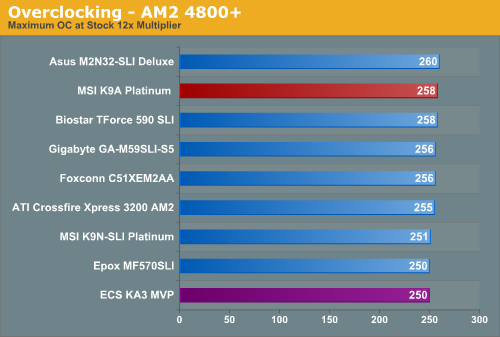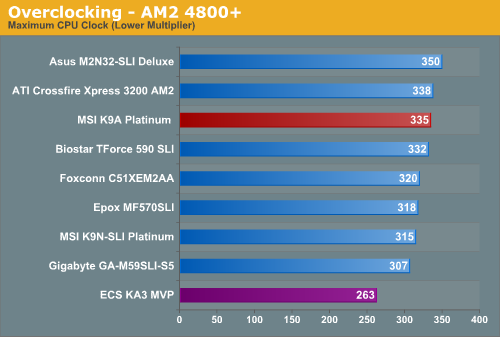AM2 Motherboards-Part 4: ATI Crossfire Xpress 3200
by Wesley Fink on August 21, 2006 7:00 AM EST- Posted in
- Motherboards
Overclocking Comparison
If we only had results from AMD processors and we were comparing AM2 results, we would be absolutely blown away by the results of the AMD OC testing. All of the AM2 boards except the problematic ECS overclocked to beyond 300 MHz bus speed and many reached or came close to 350. This represents a 50 to 75% overclock of the base clocks which is testament to the high speed capabilities of both the NVIDIA and ATI chipsets.
Testing overclocks at the stock 12x multiplier is more a measure of the overclocking ability of the CPU, but even here all the boards reached the 250 to 260 range - a 25% to 30% overclock. Compared to our last results with Socket 939, these AM2 results are remarkable - even more so because we are still dealing with a 90nm process on AM2 and we really shouldn't find this kind of headroom still remaining in a CPU near the end of a process life.


Of course we don't live in a vacuum and reality sets in when you compare results with the 65nm Intel Core 2 Duo. We have seen Core 2 Duo stock speed overclocks of as much as 100%, and bus speeds of 450 -- or about a 70% OC of the 266 bus -- have been achieved with air cooling.
As a die-shrink happens with AM2 next year we will likely see even greater overclocks to put bigger smiles on our faces. It's fair to say, though, AM2 or Core 2 Duo, that it's a good time to be an overclocker again. With the right board and the right CPU you can now achieve new performance levels with either AM2 or Core2 Duo.
Looking at the AM2 results a few boards stand out in the overclocking arena. The ASUS M2N32-SLI Deluxe and the MSI K9A Platinum are the top boards for overclocking, reaching 350 and 335 respectively with stability. In fact, any AM2 board we've tested in these four articles will get you to 307 or higher except the ECS KA3. This superb performance pretty much across the board makes price an important consideration, and here the Epox MF570SLI stands out in providing great overclocking at a small price.
If we only had results from AMD processors and we were comparing AM2 results, we would be absolutely blown away by the results of the AMD OC testing. All of the AM2 boards except the problematic ECS overclocked to beyond 300 MHz bus speed and many reached or came close to 350. This represents a 50 to 75% overclock of the base clocks which is testament to the high speed capabilities of both the NVIDIA and ATI chipsets.
Testing overclocks at the stock 12x multiplier is more a measure of the overclocking ability of the CPU, but even here all the boards reached the 250 to 260 range - a 25% to 30% overclock. Compared to our last results with Socket 939, these AM2 results are remarkable - even more so because we are still dealing with a 90nm process on AM2 and we really shouldn't find this kind of headroom still remaining in a CPU near the end of a process life.


Of course we don't live in a vacuum and reality sets in when you compare results with the 65nm Intel Core 2 Duo. We have seen Core 2 Duo stock speed overclocks of as much as 100%, and bus speeds of 450 -- or about a 70% OC of the 266 bus -- have been achieved with air cooling.
As a die-shrink happens with AM2 next year we will likely see even greater overclocks to put bigger smiles on our faces. It's fair to say, though, AM2 or Core 2 Duo, that it's a good time to be an overclocker again. With the right board and the right CPU you can now achieve new performance levels with either AM2 or Core2 Duo.
Looking at the AM2 results a few boards stand out in the overclocking arena. The ASUS M2N32-SLI Deluxe and the MSI K9A Platinum are the top boards for overclocking, reaching 350 and 335 respectively with stability. In fact, any AM2 board we've tested in these four articles will get you to 307 or higher except the ECS KA3. This superb performance pretty much across the board makes price an important consideration, and here the Epox MF570SLI stands out in providing great overclocking at a small price.










28 Comments
View All Comments
mike6099 - Thursday, September 21, 2006 - link
The review does not list the ASUS M2N32-SLI as having raid 5. however, at newegg it lists that it does. does the ASUS M2N32-SLI indeed have raid 5 capability?dougcook - Friday, September 8, 2006 - link
Be careful with the MSI K9A. If you get one, you'll probably want to get a better chipset cooler for it.I bought an MSI K9A board (after reading this review). The 570 chipset seemed about right for me. Everything seemed ok (some things seemed a bit cheap, but nothing really unusual). There were reports about it being incompatible with some memory, so I was careful there and got the good stuff. I got it all installed and it looked like it was running fine...
For one day (until I actually tried to use it).
The first real thing I did was burn a few CDs. In the middle of the 3rd CD, the Northbridge overheated and the machine turned itself off. This happened 2 more times, and then the machine failed to boot at all (even after giving it time to cool off). I wasn't overclocking, and the box had decent ventilation. The CPU's temperature was fine, the GPU's temperature was fine, the case temperature was fine, but the chipset temperature was through the roof. I had to return the motherboard.
This may not happen for everybody, but looking on NewEgg, it seems that this has happened to many other people. The MSI northbridge does not have an adequate heatsink and is likely to burn up. Save the time and get something better. I got the equivalent ABit 570 SLI motherboard, and I've been very happy so far. I hear good things about the ASUS 570 as well.
Stele - Wednesday, August 23, 2006 - link
Great article! If only there were more Xpress 3200 boards on the market now... perhaps Anandtech would do a further roundup when that is the case?Good to see that most motherboard manufacturers are keeping that 24-pin ATX connector well at the edge. So far the only outstanding exception to this practice seems to be EpoX...
As for the 4-pin 12V connector, well, it may not be the best place to be for airflow and cable routing reasons, but that location is actually part of the ATX form factor specifications, which clearly states that the 12V connector should be "next to Voltage Regulator" (ATX Specification v2.2, pg 8). Motherboard designers likely just followed that to make life easier. Specifications aside, it also makes much engineering sense as it keeps traces short - crucial to maintain the quality of power supplied to something as important as the CPU VRM. Besides, airflow considerations are less of an issue with respect to four strands of wire.
IMHO perhaps the one improvement the designers could do while keeping with the spirit of the specifications would be to put the connector on the other side of the VRM, nearer the motherboard edge, though still at the I/O side of the motherboard instead of at the edges nearer the 24-pin ATX connector.
lopri - Wednesday, August 23, 2006 - link
Boy, do I love this article! Thanks to Wesley for this great review. Usually in previous AT motherboard reviews, many difficulties/bugs that end-users experience were often overlooked. (Warm-boot, Cold-boot, Vdroop(?), etc.) I sort of understood it as a result of working with motherboard manufacturers (It's been mentioned that they get BIOS updates on a daily basis), but I used to think AT's motherboard reviews were somewhat different from end-users' experience of retail products.This review feels much realer and it sounded almost like what I went through with a couple of the boards that I bought after reading AT reviews. I'm very glad and grateful, and hope AT keeps this critical viewpoints for future reviews, especially for motherboards.
lop
Le Québécois - Monday, August 21, 2006 - link
When you are talking about the SB600 featuresShouldn't it be: Athlon 64, Athlon 64 X2, Athlon FX, Sempron... To my knowledge Amd have Athlon 64 X2 ;) and even if the FX-60 (939) and the FX-62(AM2) have 2 core AMD still call them simply by FX and not FX X2.
JarredWalton - Monday, August 21, 2006 - link
Edited. Basically, SB600+RD580 supports all current 939/AM2 AMD CPUs. Not sure about SB460, as Wes specifically didn't list dual core and Opteron parts there. I would guess it does, but I will leave that edit to him just to be safe.Furen - Monday, August 21, 2006 - link
=)He just meant that FX X2 doesn't exist. There are A64s X2s and A64 FXes but even the dual-core parts are plain FXes.
mendocinosummit - Monday, August 21, 2006 - link
So, awards were handed out despite the fact that ASUS and other top mobo manus don't have ATI boards yet? Am I to assume that this is the end of the mobo lineup? I would really like to see at least two more boards featuring a ATI chipset; especially since the ECS board will basically be a flop at launch.Gary Key - Monday, August 21, 2006 - link
We also have a few mATX AM2 boards along with a couple of value solutions that we will be reviewing shortly. There is still the upcoming DFI 590SLI AM2 board to review also. :)yyrkoon - Monday, August 21, 2006 - link
Will you guys be testing any of the ABIT boards ? For me personaly, so far, my choice is the ABIT AN9 32x (non fata1ity). I like this board because it offers the SIL 3132 controller, and has an eSATA socket in the I/O section. This is, I'm hoping to use this board with a SATA port multiplier, for some external RAID 5 goodness :)